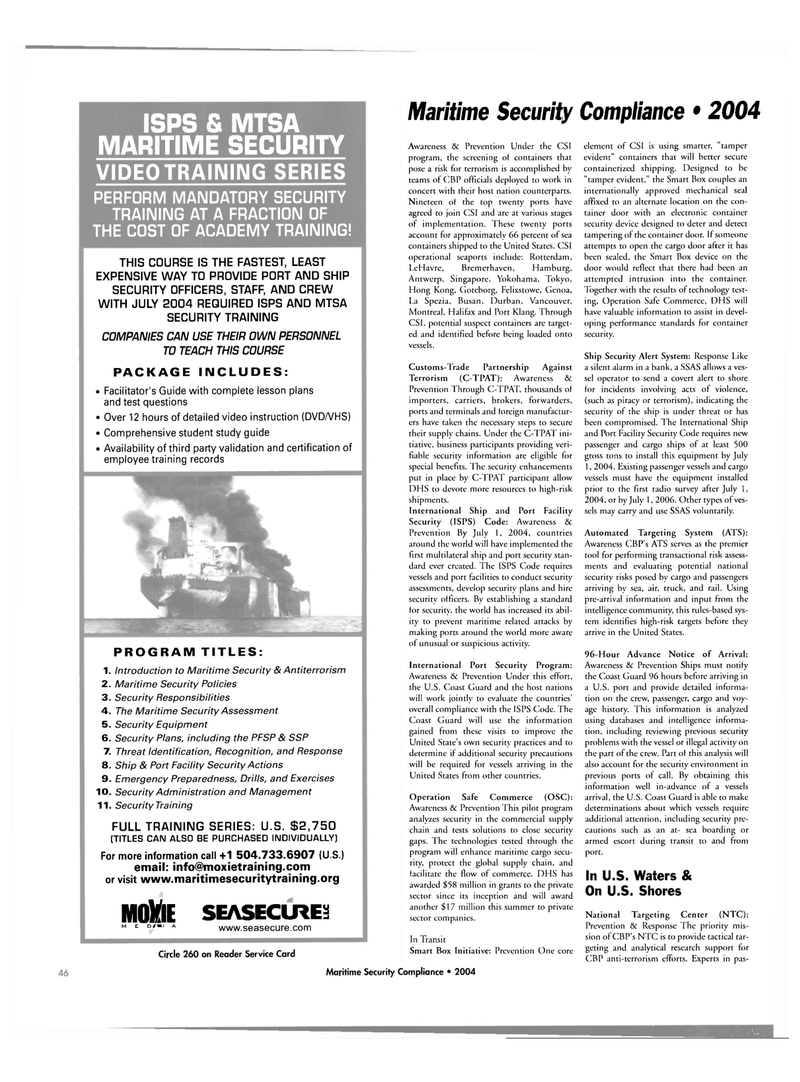
Page 46: of Maritime Reporter Magazine (July 2004)
Gulf of Mexico: Floating Production Systems & Support Vessels
Read this page in Pdf, Flash or Html5 edition of July 2004 Maritime Reporter Magazine
ISPS & MTSA MARITIME SECURITY
VIDEO TRAINING SERIES
PERFORM MANDATORY SECURITY
TRAINING AT A FRACTION OF
THE COST OF ACADEMY TRAINING!
THIS COURSE IS THE FASTEST, LEAST
EXPENSIVE WAY TO PROVIDE PORT AND SHIP
SECURITY OFFICERS, STAFF, AND CREW
WITH JULY 2004 REQUIRED ISPS AND MTSA
SECURITY TRAINING
COMPANIES CAN USE THEIR OWN PERSONNEL
TO TEACH THIS COURSE
PACKAGE INCLUDES: • Facilitator's Guide with complete lesson plans and test questions • Over 12 hours of detailed video instruction (DVDA/HS) • Comprehensive student study guide • Availability of third party validation and certification of employee training records
PROGRAM TITLES: 1. Introduction to Maritime Security & Antiterrorism 2. Maritime Security Policies 3. Security Responsibilities 4. The Maritime Security Assessment 5. Security Equipment 6. Security Plans, including the PFSP & SSP 7. Threat Identification, Recognition, and Response 8. Ship & Port Facility Security Actions 9. Emergency Preparedness, Drills, and Exercises 10. Security Administration and Management 11. SecurityTraining
FULL TRAINING SERIES: U.S. $2,750 (TITLES CAN ALSO BE PURCHASED INDIVIDUALLY)
For more information call +1 504.733.6907 (U.S.) email: [email protected] or visit www.maritimesecuritytraining.org
MOME SEASECLRES
M E D ' A www.seasecure.com
Circle 260 on Reader Service Card
Maritime Security Compliance • 2004
Awareness & Prevention Under the CSI program, the screening of containers that pose a risk for terrorism is accomplished by teams of CBP officials deployed to work in concert with their host nation counterparts.
Nineteen of the top twenty ports have agreed to join CSI and are at various stages of implementation. These twenty ports account for approximately 66 percent of sea containers shipped to the United States. CSI operational seaports include: Rotterdam,
LeHavre, Bremerhaven, Hamburg,
Antwerp, Singapore, Yokohama, Tokyo,
Hong Kong, Goteborg, Felixstowe, Genoa,
La Spezia, Busan, Durban, Vancouver,
Montreal, Halifax and Port Klang. Through
CSI, potential suspect containers are target- ed and identified before being loaded onto vessels.
Customs-Trade Partnership Against
Terrorism (C-TPAT): Awareness &
Prevention I hrough C-TPAT, thousands of importers, carriers, brokers, forwarders, ports and terminals and foreign manufactur- ers have taken the necessary steps to secure their supply chains. Under the C-TPAT ini- tiative, business participants providing veri- fiable security information are eligible for special benefits. The security enhancements put in place by C-TPAT participant allow
DHS to devote more resources to high-risk shipments.
International Ship and Port Facility
Security (ISPS) Code: Awareness &
Prevention By July l, 2004, countries around the world will have implemented the first multilateral ship and port security stan- dard ever created. The ISPS Code requires vessels and port facilities to conduct security assessments, develop security plans and hire security officers. By establishing a standard for security, the world has increased its abil- ity to prevent maritime related attacks by making ports around the world more aware of unusual or suspicious activity.
International Port Security Program:
Awareness & Prevention Under this effort, the U.S. Coast Guard and the host nations will work jointly to evaluate the countries' overall compliance with the ISPS Code. The
Coast Guard will use the information gained from these visits to improve the
United State's own security practices and to determine if additional security precautions will be required for vessels arriving in the
United States from other countries.
Operation Safe Commerce (OSC):
Awareness & Prevention This pilot program analyzes security in the commercial supply chain and tests solutions to close security gaps. The technologies tested through the program will enhance maritime cargo secu- rity, protect the global supply chain, and facilitate the flow of commerce. DHS has awarded $58 million in grants to the private sector since its inception and will award another $17 million this summer to private sector companies.
In Transit
Smart Box Initiative: Prevention One core element of CSI is using smarter, "tamper evident" containers that will better secure containerized shipping. Designed to be "tamper evident," the Smart Box couples an internationally approved mechanical seal affixed to an alternate location on the con- tainer door with an electronic container security device designed to deter and detect tampering of the container door. If someone attempts to open the cargo door after it has been sealed, the Smart Box device on the door would reflect that there had been an attempted intrusion into the container.
Together with the results of technology test- ing, Operation Safe Commerce, DHS will have valuable information to assist in devel- oping performance standards for container security.
Ship Security Alert System: Response Like a silent alarm in a bank, a SSAS allows a ves- sel operator to send a covert alert to shore for incidents involving acts of violence, (such as piracy or terrorism), indicating the security of the ship is under threat or has been compromised. The International Ship and Port Facility Security Code requires new passenger and cargo ships of at least 500 gross tons to install this equipment by July 1, 2004. Existing passenger vessels and cargo vessels must have the equipment installed prior to the first radio survey after July 1, 2004, or by July 1, 2006. Other types of ves- sels may carry and use SSAS voluntarily.
Automated Targeting System (ATS):
Awareness CBP's ATS serves as the premier tool for performing transactional risk assess- ments and evaluating potential national security risks posed by cargo and passengers arriving by sea, air, truck, and rail. Using pre-arrival information and input from the intelligence community, this rules-based sys- tem identifies high-risk targets before they arrive in the United States. 96-Hour Advance Notice of Arrival:
Awareness & Prevention Ships must notify the Coast Guard 96 hours before arriving in a U.S. port and provide detailed informa- tion on the crew, passenger, cargo and voy- age history. This information is analyzed using databases and intelligence informa- tion, including reviewing previous security problems with the vessel or illegal activity on the part of the crew. Part of this analysis will also account for the security environment in previous ports of call. By obtaining this information well in-advance of a vessels arrival, the U.S. Coast Guard is able to make determinations about which vessels require additional attention, including security pre- cautions such as an at- sea boarding or armed escort during transit to and from port.
In U.S. Waters &
On U.S. Shores
National Targeting Center (NTC):
Prevention & Response The priority mis- sion of CBP's NTC is to provide tactical tar- geting and analytical research support for
CBP anti-terrorism efforts. Experts in pas-
Maritime Security Compliance • 2004

 45
45

 47
47
